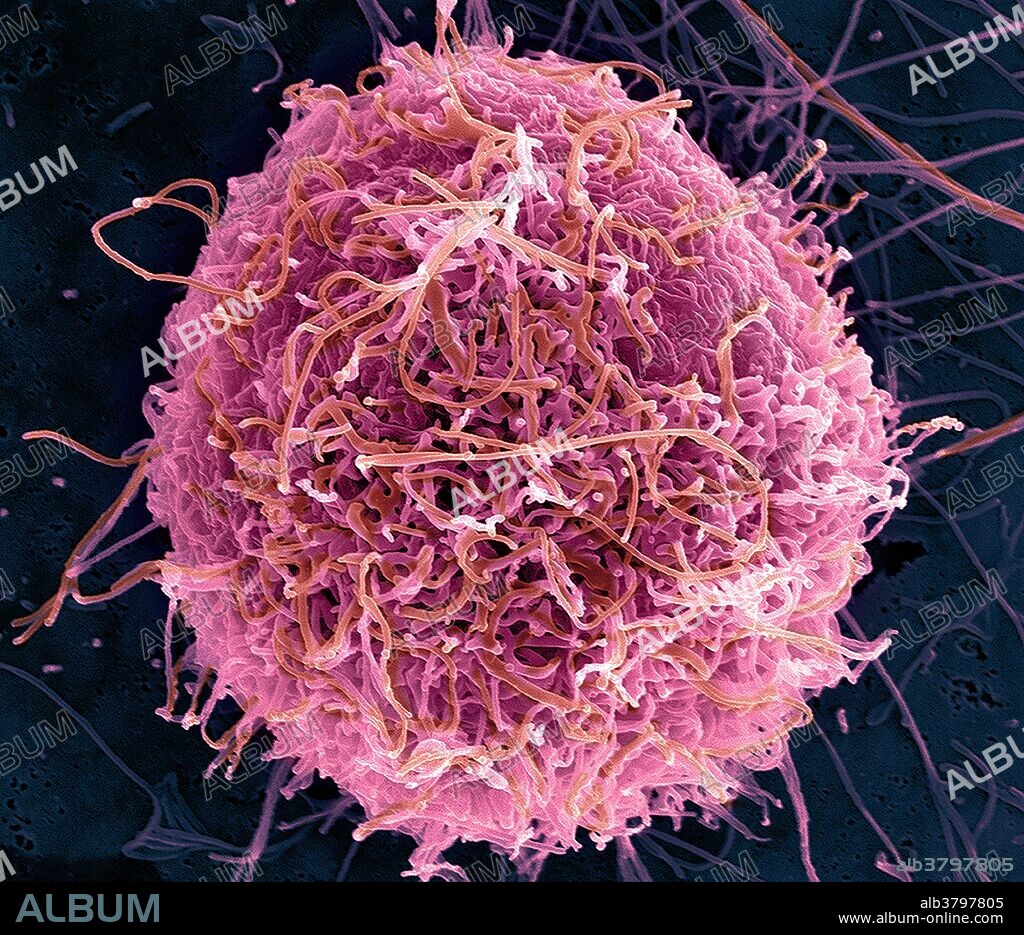alb3797805
Ebola Virus Particles, SEM

|
Add to another lightbox |
|
Add to another lightbox |



Buy this image.
Select the use:

Title:
Ebola Virus Particles, SEM
Caption:
Scanning electron micrograph of filamentous Ebola virus particles budding from a single chronically-infected VERO E6 cell (25,000x magnification). Ebola hemorrhagic fever (Ebola HF) is a severe, often-fatal disease in humans and nonhuman primates (monkeys, gorillas, and chimpanzees) that has appeared sporadically since its initial recognition in 1976. The disease is caused by infection with Ebola virus, named after a river in the Democratic Republic of the Congo (formerly Zaire) in Africa, where it was first recognized. The virus is one of two members of a family of RNA viruses called the Filoviridae. There are four identified subtypes of Ebola virus. Three of the four have caused disease in humans: Ebola-Zaire, Ebola-Sudan, and Ebola-Ivory Coast. The fourth, Ebola-Reston, has caused disease in nonhuman primates, but not in humans. Vero cells are derived from the kidney of an African green monkey (Cercopithecus aethiops) in the 1960s, Vero cells are one of the most common mammalian continuous cell lines used in research. This anchorage-dependent cell line has been used extensively in virology studies.
Category:
Microbiology: Virus
Credit:
Album / Science Source
Releases:
Image size:
3900 x 3359 px | 37.5 MB
Print size:
33.0 x 28.4 cm | 13.0 x 11.2 in (300 dpi)
Keywords:
(-) SSRNA VIRUS • -SSRNA VIRUS • ABNORMAL • ANCHORAGE DEPENDENT CELL LINE • ANCHORAGE-DEPENDENT CELL LINE • COLORIZED • COMMUNICABLE DISEASE • DISEASED • EBOLA HAEMORRHAGIC FEVER • EBOLA HEMORRHAGIC FEVER • EBOLA VIRUS DISEASE • EBOLA VIRUS • EBOLA • EBOLAVIRUS • EBOV • EHV • ELECTRON MICROGRAPH • ELECTRON MICROSCOPY • EM • ENHANCEMENT • EVD • FILOVIRIDAE • HISTOPATHOLOGICAL • HISTOPATHOLOGY • INFECTIOUS AGENT • INFECTIOUS DISEASE • MEDICAL • MEDICINAL • MICROBIOLOGY • MICROBIOLOGY: VIRUS • MICROGRAPH • MICROORGANISM • MICROSCOPIC ORGANISM • MICROSCOPIC • MICROSCOPY • MONONEGAVIRALES • NEGATIVE-SENSE • PATHOGEN • PATHOGENIC • PATHOLOGICAL • PATHOLOGY • RNA VIRUS • SCANNING ELECTRON MICROGRAPH • SCANNING ELECTRON MICROSCOPE • SCIENCE • SEM • SINGLE-STRANDED • TRANSMISSIBLE DISEASE • ULTRASHORT WAVE • ULTRASTRUCTURAL MORPHOLOGY • UNHEALTHY • VERO CELL • VERO E6 CELL LINE • VERY HIGH FREQUENCY • VHF • VIRAL DISEASE • VIRAL HAEMORRHAGIC FEVER • VIRAL HEMORRHAGIC FEVER • VIRAL • VIRION • VIROLOGY • VIRUS PARTICLES • VIRUS


 Pinterest
Pinterest Twitter
Twitter Facebook
Facebook Copy link
Copy link Email
Email
